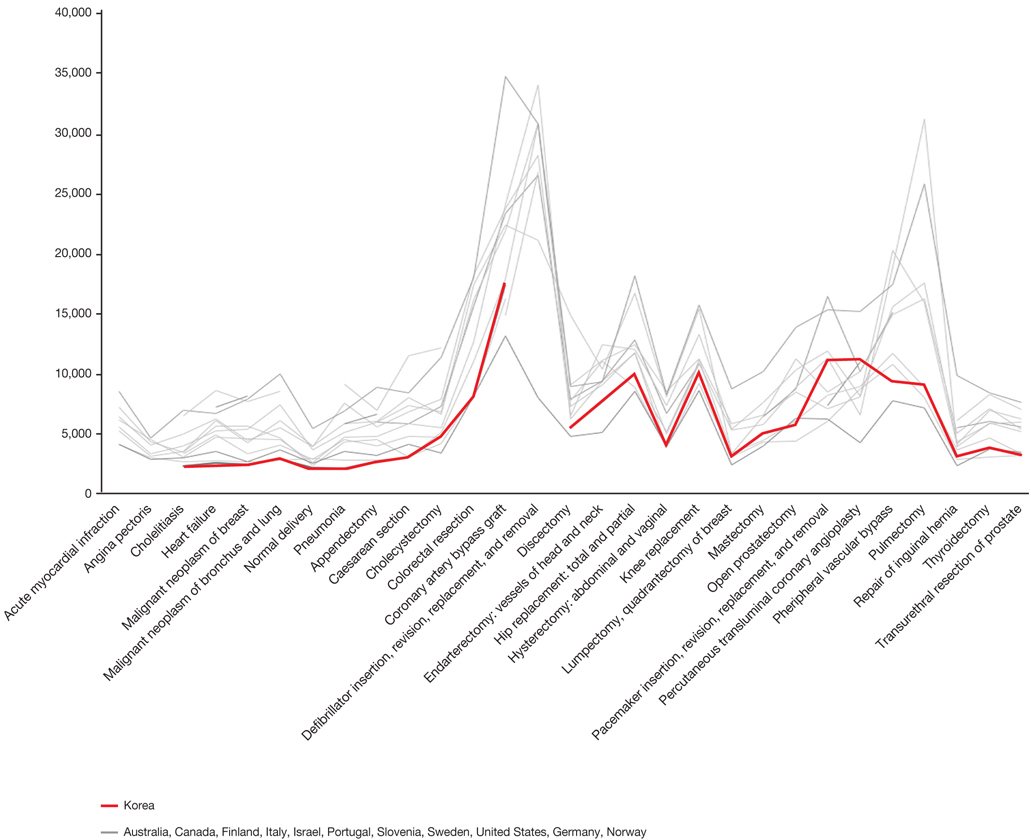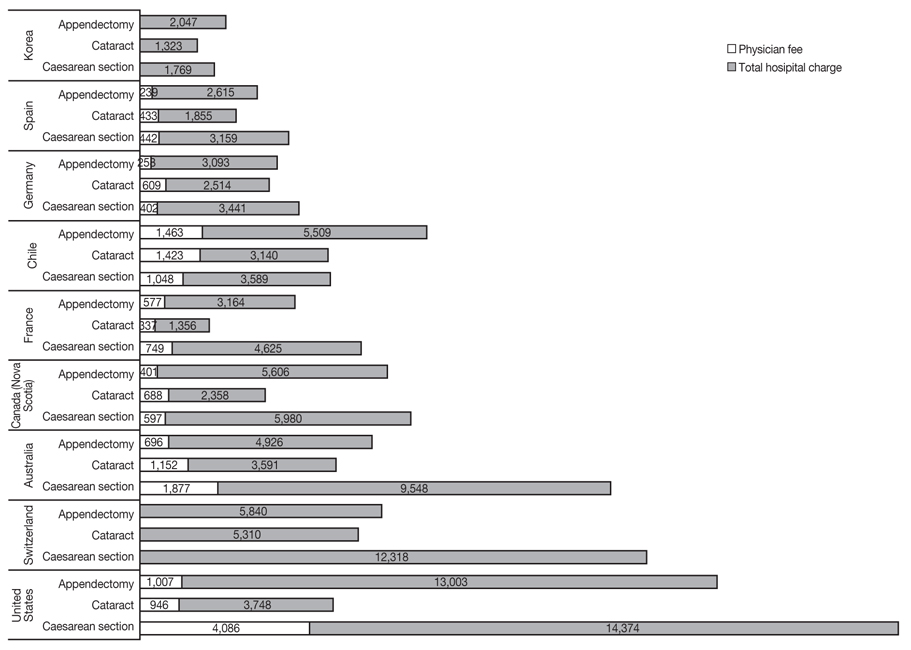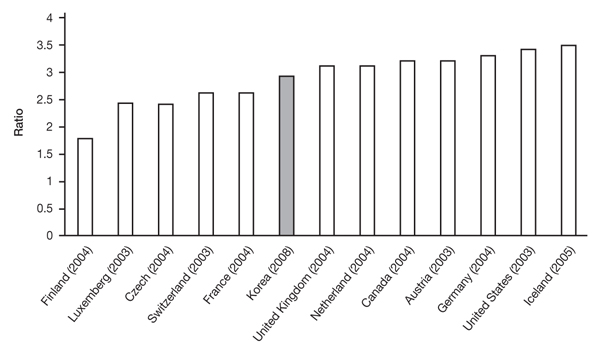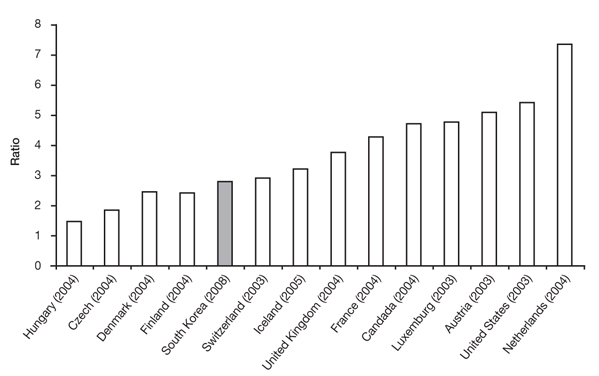J Korean Med Assoc.
2013 Jun;56(6):523-532.
Comparative study on medical fees: caesarean section, cataract, and appendectomy surgeries among OECD countries
- Affiliations
-
- 1Korea Insurance Research Institute, Seoul, Korea.
- 2Department of Health Administration, College of Health Science, Yonsei University, Wonju, Korea. haejongl@yonsei.ac.kr
- 3Graduate School of Public Health, The Catholic University of Korea, Seoul, Korea.
Abstract
- The question has been raised whether the medical fee schedule is very low in Korea. However, studies that empirically address this matter on a national scale are rare. This study attempted to determine the level of Korea's medical fees for caesarean section (C-section), cataract, and appendectomy surgeries by comparing and analyzing them with other Organization for Economic Cooperation and Development (OECD) countries' medical cost data obtained from other studies. There are two ways to compare the level of medical fees: one is a direct comparison, which obtains each country's medical fee schedule and compares them with each other. Another is indirect comparison, a method which compares data such as physician income. For direct comparison, fees were calculated using data provided by the OECD and Health Insurance Review and Assessment. For indirect comparison by physician income, data obtained from Korea Employment Information Services were used to represent Korean physician income. When compared with other OECD countries, the results suggest that, overall, the Korean fee schedule could be low, based on the fees for C-section, cataract, and appendectomy surgeries. The study results also confirm that Korean physicians' average earnings ranked relatively low among OECD countries. These results are meaningful in that they empirically support the contention that Korean medical fees could be low. In addition, under what is known as national health insurance, in which the medical fee schedule is determined by a single payer, an empirical analysis on medical fee levels, as in this study, has substantial political implications because it may be utilized for medical fee schedule negotiation in the near future. An attempt to directly research fees and the range of services of OECD countries is still needed in order to provide more established data.
Keyword
MeSH Terms
Figure
Reference
-
1. Kang KW. Medical payment system and national health insurance fee. Cheongju: Chungbuk National University College of Medicine;2010.2. Kim JH. The Korean Association for Policy Studies. Cybernetics interpretation on national health insurance fee decision and change. Paper presented at the Korean Association for Policy Studies International Conference. 2010 Jul 19; Seoul, Koera. Seoul: The Korean Association for Policy Studies;2010. p. 417–438.3. Choi HK. An analysis on the process of setting fees for medical and pharmaceutical services in the National Health Insurance and the role of the government in the process. Korean Public Adm Rev. 2004; 38:127–147.4. Kim CY. The Korean Association of Internal Medicine. Implementation of DRG and its effect. Korean Association of Internal Medicine Spring Conference. 2000 Apr 29; Gyeongju, Korea. Seoul: The Korean Association of Internal Medicine;2000. p. 13–14.5. Park EC. Relative value development for national health insurance payment syetem reform. Korean J Dermatol. 1996; 34:36.6. Park KI, Lee BH, Bae WK, Song YS, Ko SH, Lee MD, Yu IH, Kim CB, Kim YS, Mun IS, Kim YS. Progress report on KCPT and RBRVS. Seoul: Korean Surgical Society;1997.7. Lee MR, Lee YH, Koh KW. The change of medical care pattern and cost of cataract surgery by the DRG payment system in a general hospital. Korean J Hosp Manage. 2005; 10:48–70.8. Lee YG. The Korean Social Security Association. Global budget and drug related group. Finance and innovation of Korean social security in 21st century. In : Korean Social Security Association Spring Conference; 2001; Seoul, Korea. Seoul: The Korean Social Security Association;2001. p. 177–203.9. Lee JY. Korean health care system and a suggestion for its improvement. J Soc Sci. 2000; 19:63–79.10. Lee CH. The Korean Association of Internal Medicine. Problems with national health insurance fee. In : Korean Association of Internal Medicine Spring Conference; 2000 Apr 29; Gyeongju, Korea. Seoul: The Korean Association of Internal Medicine;2000. p. 15–19.11. Chae HY, Park JY. DRG payment system and health care providers' incentives. Bogeongyeongjeyeongu. 2003; 9:1–24.12. Health Insurance Review and Assessment Service. Relative value point reform study report. Seoul: Health Insurance Review and Assessment Service;2006.13. Lee CW, Lee KH. Healthcare market overview and insurer's response strategy. Seoul: Korea Insurance Research Institute;2011.14. Mogyorosy Z, Smith P. The main methodological issues in costing health care services: a literature review. York: Centre for Health Economics, University of York;2005.15. Koechlin F, Lorenzoni L, Schreyer P. Comparing price levels of hospital services across countries: results of a pilot study. Paris: Organization for Economic Cooperation and Development Publishing;2010.16. International Federation of Health Plans. 2011 Comparative price report: medical and hospital fees by country. London: International Federation of Health Plans;2012.17. Fujisawa R, Lafortune G. The remuneration of general practitioners and specialists in 14 OECD countries: what are the factors influencing variations across countries? Paris: Organization for Economic Cooperation and Development Publishing;2008.18. Ministry of Health and Welfare. Health Insurance Review and Assessment Service. OJT materials for diagnosis related group. Seoul: Ministry of Health and Welfare;2003.19. Kim SH. Health care reform lag in Korea by actor-centered institutionalism: in case of DRG payment system policy. Korean Policy Stud Rev. 2009; 18:125–155.20. Kang KW. Korean Academy of Health Policy and Management. Significance and contention related to introduction of refined DRG. In : The 45th Korean Academy of Health Policy and Management Fall Conference; 2010 Nov 19; Gwangju, Korea. Seoul: Korean Academy of Health Policy and Management;2010. p. 21–37.21. Health Insurance Review and Assessment Service. DRG fee schedule (effective from 2012 Jul 1) [Internet]. Seoul: Health Insurance Review and Assessment Service;2012. cited 2012 Jul 14. Available from: http://www.hira.or.kr/dummy.do?pgmid=HIRAA030066040000&cmsurl=cms/law/02/04/04/1212279_13434.html.22. Korea Employment Information Service. OES: occupational employment statistics 2008 [Internet]. Seoul: National Human Resources Development;2008. cited 2012 Jul 20. Available from: http://www.nhrd.net/board/view.do?dataSid=16400&boardId=BBS_000006&menuCd=DOM_000000102005000000.23. Choi BH, Shin YS. International trends and restructure directions of health insurance fee systems. Seoul: Korea Institute for Health and Social Affairs;1997.24. Yoo IH. International comparison of medical fee. J Korean Med Assoc. 2001; 44:382–391.
Article
- Full Text Links
- Actions
-
Cited
- CITED
-
- Close
- Share
- Similar articles
-
- A Comparative Study of Suicide Rates among 10–19-Year-Olds in 29 OECD Countries
- Comparison of Nursing Workforce Supply and Employment in South Korea and Other OECD Countries
- Management of hypotension after spinal anesthesia administered for caesarean section
- A Comparison between Propofol and Thiopental for Induction of Anesthesia for Elective Caesarean Section
- The Comparative Analysis between Laparoscopic and Open Appendectomy






